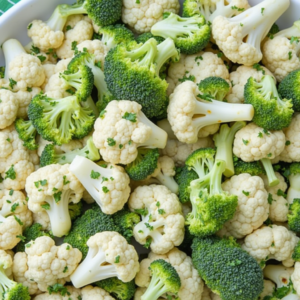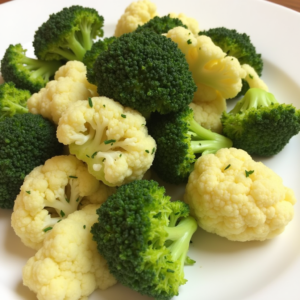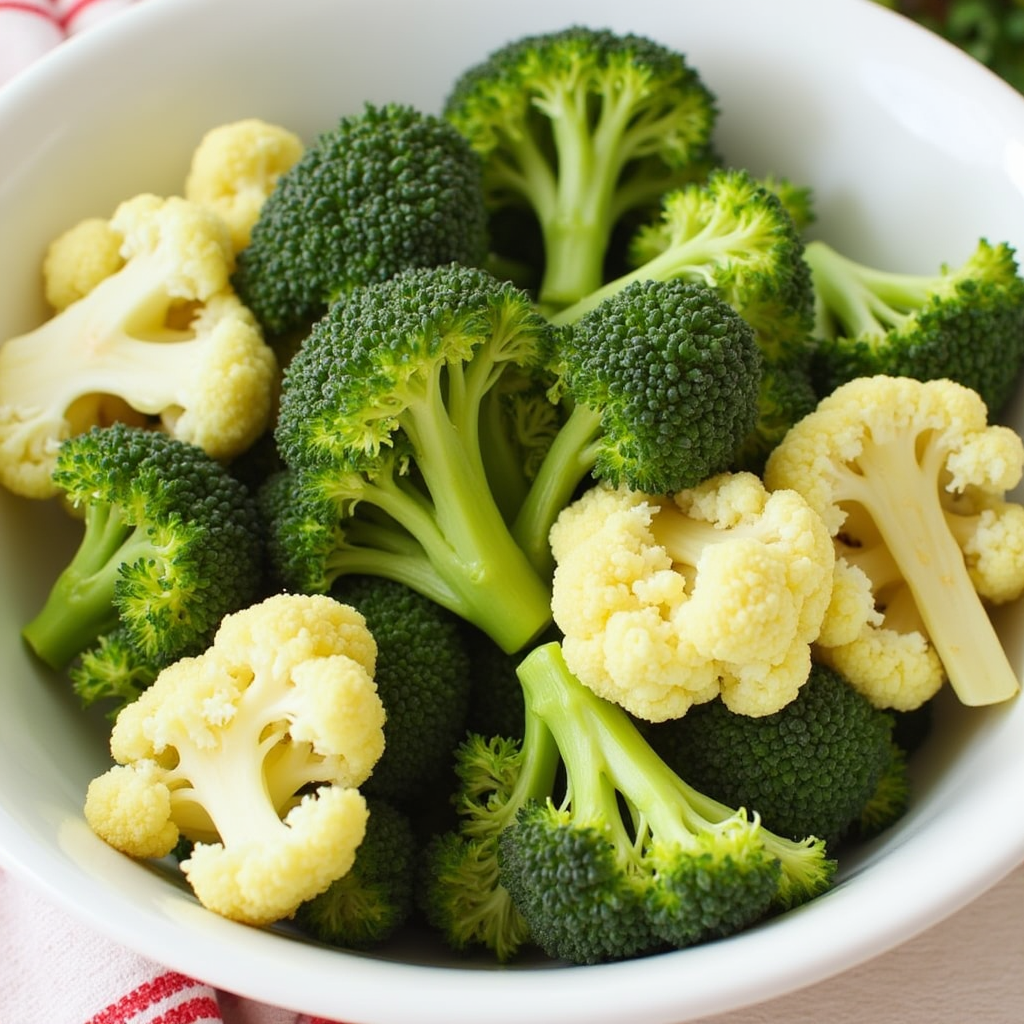Table of Contents
- Nutritional Profiles of Broccoli and Cauliflower
- The Best Ways to Cook Broccoli and Cauliflower
- Cooking Methods to Avoid
- Tips for Incorporating Broccoli and Cauliflower into Your Diet
- Conclusion
What Is the Healthiest Way to Eat Broccoli and Cauliflower?
Broccoli and cauliflower are two of the most nutritious vegetables, packed with vitamins, minerals, fiber, and powerful antioxidants. As cruciferous vegetables, they offer numerous health benefits, from supporting digestion to reducing the risk of chronic diseases. However, the way you prepare and consume them significantly impacts their nutritional value. In this in-depth guide, we will explore the best ways to eat broccoli and cauliflower to maximize their health benefits while preserving their nutrients and natural flavors.
Nutritional Profiles of Broccoli and Cauliflower
Before diving into the healthiest ways to eat these vegetables, let’s first understand their impressive nutritional content.
Broccoli Nutrition
Broccoli is a powerhouse of nutrients, including:
- Vitamin C: Strengthens the immune system, promotes healthy skin, and acts as an antioxidant.
- Vitamin K: Essential for blood clotting and bone health.
- Vitamin A: Supports vision and immune function.
- Folate: Important for cell growth and DNA formation, particularly for pregnant women.
- Potassium: Helps regulate blood pressure and muscle function.
- Fiber: Aids digestion and promotes gut health.
- Sulforaphane: A potent antioxidant that may help prevent cancer and reduce inflammation.
Cauliflower Nutrition
Cauliflower shares many of the health benefits of broccoli and is equally rich in essential nutrients:
- Vitamin C: Supports immune function and collagen production.
- Vitamin K: Crucial for blood health and bone strength.
- Choline: Supports brain development and nervous system function.
- Fiber: Improves digestion and helps regulate blood sugar levels.
- Glucosinolates: Natural compounds that support detoxification and may reduce the risk of certain cancers.
Since both vegetables provide numerous health advantages, the key to maximizing their benefits lies in how they are prepared and consumed.

The Best Ways to Cook Broccoli and Cauliflower
The method of cooking significantly affects the retention of vitamins, minerals, and antioxidants. Some cooking techniques preserve more nutrients than others, while certain methods may lead to nutrient loss. Let’s explore the healthiest ways to cook and consume broccoli and cauliflower.
1. Steaming (The Best Method)
Steaming is considered one of the healthiest ways to prepare both broccoli and cauliflower. It preserves the highest levels of vitamins and antioxidants while maintaining the vegetables’ natural texture and flavor.
Why Steaming is Best:
- Retains more vitamin C and folate compared to boiling.
- Preserves antioxidants like sulforaphane.
- Prevents the leaching of water-soluble nutrients.
How to Steam Properly:
- Fill a pot with about 1-2 inches of water and bring it to a boil.
- Place the broccoli and cauliflower in a steaming basket above the water.
- Cover with a lid and steam for 4-5 minutes until tender-crisp.
- Serve immediately with olive oil, lemon juice, or herbs for added flavor.
2. Sautéing (For Maximum Flavor & Retained Nutrients)
Sautéing is another excellent cooking method that preserves most nutrients while enhancing taste and texture.
Why Sautéing Works Well:
- Uses healthy fats like olive oil or avocado oil to enhance nutrient absorption.
- Retains most of the vitamins and antioxidants.
- Adds depth of flavor through caramelization.
How to Sauté:
- Heat a tablespoon of olive oil in a pan over medium heat.
- Add chopped broccoli and cauliflower and stir frequently for 5-7 minutes.
- Add garlic, lemon juice, or seasonings for extra flavor.
- Serve as a side dish or add to grain bowls and salads.
3. Roasting (For a Crispy, Delicious Option)
Roasting broccoli and cauliflower enhances their natural flavors, giving them a caramelized, slightly crispy texture.
Benefits of Roasting:
- Retains fiber and minerals while developing a rich taste.
- Requires minimal oil, making it a healthy option.
- Creates a satisfying texture without deep frying.
How to Roast:
- Preheat the oven to 400°F (200°C).
- Toss chopped broccoli and cauliflower with olive oil, salt, and pepper.
- Spread them evenly on a baking sheet.
- Roast for 20-25 minutes, flipping halfway for even browning.
- Serve warm with fresh herbs or grated cheese for extra flavor.
Simple Steamed Broccoli and Cauliflower with Olive Oil & Lemon
Light, healthy, and packed with flavor this simple steamed broccoli and cauliflower recipe is perfect as a side dish or a quick veggie boost! The combination of tender florets, rich olive oil, and a squeeze of fresh lemon makes it irresistibly delicious
Ingredients:
- 10 oz (280g) broccoli florets
- 10 oz (280g) cauliflower florets
- 2 tbsp olive oil
- 1 tbsp fresh lemon juice
- 1/2 tsp salt
- 1/4 tsp black pepper
- 1/4 tsp garlic powder (optional)
Directions:
Steam the veggies: In a pot with a steamer basket, bring about 1 inch of water to a boil. Add the broccoli and cauliflower, cover, and steam for 5-7 minutes until fork-tender but still vibrant.
Season: Transfer the steamed florets to a bowl. Drizzle with olive oil, squeeze in the lemon juice, and sprinkle with salt, black pepper, and garlic powder (if using). Toss well to coat.
Serve & enjoy! Plate it up and enjoy this light, zesty dish as a side for grilled chicken, fish, or your favorite main course!
Pro Tip: Want extra flavor? Add a pinch of red pepper flakes or some grated Parmesan before serving!

4. Eating Raw (For Maximum Nutrient Intake)
Raw broccoli and cauliflower retain all their vitamins, minerals, and antioxidants since no heat is applied.
Why Eat Them Raw?
- Retains sulforaphane and glucosinolates, which may be reduced by cooking.
- Maintains all water-soluble vitamins, including vitamin C and folate.
- Provides a crunchy texture that works well in salads and snacks.
How to Eat Raw:
- Chop into bite-sized pieces and dip in hummus or yogurt-based dressings.
- Add to salads for extra crunch.
- Shred cauliflower into rice-like grains for a raw cauliflower rice dish.
Cooking Methods to Avoid
While many methods preserve nutrients, some techniques significantly reduce the nutritional benefits of broccoli and cauliflower.
1. Boiling (Causes Nutrient Loss)
Boiling broccoli and cauliflower in water can cause water-soluble vitamins like vitamin C and folate to leach into the cooking water.
How to Reduce Nutrient Loss When Boiling:
- Use minimal water and avoid overcooking.
- Consider using the boiling water in soups or sauces to recover some lost nutrients.
2. Deep Frying (Unhealthy Fats & Nutrient Destruction)
Frying these vegetables at high temperatures can:
- Destroy antioxidants and essential vitamins.
- Add unhealthy fats, increasing calorie intake.
- Lead to harmful compound formation from overcooking oils.
Instead, opt for air frying or baking as healthier alternatives.
Tips for Incorporating Broccoli and Cauliflower into Your Diet
- Blend into Smoothies: Add raw broccoli or cauliflower to green smoothies for a nutrient boost.
- Make Soups: Blend steamed or roasted vegetables into soups for a creamy, flavorful dish.
- Create Veggie-Based Pizza Crusts: Use cauliflower rice as a base for low-carb pizza crusts.
- Toss into Stir-Fries: Combine with lean proteins, soy sauce, and spices for a quick and healthy meal.
- Use as a Low-Carb Substitute: Swap cauliflower for rice, mashed potatoes, or even pasta alternatives.
Broccoli vs. Cauliflower: Which One is Healthier?
While both broccoli and cauliflower are packed with essential nutrients, some key differences might make one a better choice depending on individual health needs. Broccoli is higher in vitamin C and vitamin K, making it ideal for immune support and bone health. It also contains more sulforaphane, a powerful antioxidant linked to cancer prevention. On the other hand, cauliflower is an excellent low-carb alternative to grains, making it a great option for those following ketogenic or low-carb diets. It also provides choline, a nutrient essential for brain function and development. Ultimately, the best choice is to incorporate both into your diet, as they complement each other nutritionally.
Conclusion
Broccoli and cauliflower are nutritional powerhouses that provide essential vitamins, minerals, fiber, and antioxidants. To maximize their health benefits, steaming, sautéing, roasting, and eating them raw are the best preparation methods. Avoid boiling and deep frying, as they can lead to significant nutrient loss. By incorporating these vegetables into a balanced diet through various creative and delicious recipes, you can fully enjoy their numerous health advantages while keeping your meals flavorful and satisfying.
Whether eaten raw, steamed, or roasted, adding broccoli and cauliflower to your diet is one of the healthiest choices you can make for long term wellness.

